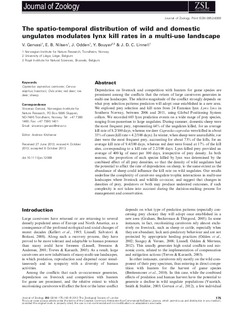| dc.contributor.author | Gervasi, Vincenzo | |
| dc.contributor.author | Nilsen, Erlend Birkeland | |
| dc.contributor.author | Odden, John | |
| dc.contributor.author | Bouyer, Yaëlle | |
| dc.contributor.author | Linnell, John Durrus | |
| dc.coverage.spatial | Sothern Norway | nb_NO |
| dc.date.accessioned | 2018-01-04T11:47:39Z | |
| dc.date.available | 2018-01-04T11:47:39Z | |
| dc.date.created | 2014-03-26T10:44:03Z | |
| dc.date.issued | 2014 | |
| dc.identifier.citation | Journal of Zoology. 2014, 292 (3), 175-183. | nb_NO |
| dc.identifier.issn | 0952-8369 | |
| dc.identifier.uri | http://hdl.handle.net/11250/2475595 | |
| dc.description.abstract | Depredation on livestock and competition with hunters for game species are prominent among the conflicts that the return of large carnivores generates in multi-use landscapes. The relative magnitude of the conflict strongly depends on what prey selection patterns predators will adopt once established in a new area. We explored prey selection and kill rates from 24 Eurasian lynx Lynx lynx in Southern Norway, between 2006 and 2011, using Global Positioning System collars. We recorded 603 lynx predation events on a wide range of prey species, ranging from passerines to large ungulates. During summer, domestic sheep were the most frequent prey, representing 64% of the ungulates killed, for an average kill rate of 8.2/100 days, whereas roe deer Capreolus capreolus were killed in about 33% of cases (kill rate = 4.2/100 days). In winter, when sheep were unavailable, roe deer were the most frequent prey, accounting for about 73% of the kills, for an average kill rate of 9.4/100 days, whereas red deer were found at 17% of the kill sites, corresponding to a kill rate of 2.2/100 days. Lynx-killed prey provided an average of 400 kg of meat per 100 days, irrespective of prey density. In both seasons, the proportion of each species killed by lynx was determined by the combined effect of all prey densities, so that the density of wild ungulates had the potential to affect the rate of depredation on sheep, to the same extent as the abundance of sheep could influence the kill rate on wild ungulates. Our results underline the complexity of carnivore–ungulate trophic interactions in multi-use landscapes where livestock and wildlife co-occur, and suggest that changes in densities of prey, predators or both may produce undesired outcomes, if such complexity is not taken into account during the decision-making process for management and conservation. Capreolus capreolus; carnivore; Cervus elaphus; livestock; Ovis aries; red deer; roe deer; sheep. | nb_NO |
| dc.language.iso | eng | nb_NO |
| dc.rights | Attribution-NonCommercial-NoDerivatives 4.0 Internasjonal | * |
| dc.rights.uri | http://creativecommons.org/licenses/by-nc-nd/4.0/deed.no | * |
| dc.subject | Capreolus capreolus | nb_NO |
| dc.subject | carnivore | nb_NO |
| dc.subject | Cervus elaphus | nb_NO |
| dc.subject | livestock | nb_NO |
| dc.subject | Ovis aries | nb_NO |
| dc.subject | red deer | nb_NO |
| dc.subject | roe deer | nb_NO |
| dc.subject | sheep | nb_NO |
| dc.title | The spatio-temporal distribution of wild and domestic ungulates modulates lynx kill rates in a multi-use landscape | nb_NO |
| dc.type | Journal article | nb_NO |
| dc.type | Peer reviewed | nb_NO |
| dc.description.version | publishedVersion | nb_NO |
| dc.subject.nsi | VDP::Matematikk og Naturvitenskap: 400::Zoologiske og botaniske fag: 480 | nb_NO |
| dc.source.pagenumber | 175-183 | nb_NO |
| dc.source.volume | 292 | nb_NO |
| dc.source.journal | Journal of Zoology | nb_NO |
| dc.source.issue | 3 | nb_NO |
| dc.identifier.doi | 10.1111/jzo.12088 | |
| dc.identifier.cristin | 1124781 | |
| dc.relation.project | Andre: Direktoratet for naturforvaltning | nb_NO |
| dc.relation.project | Andre: Nature Protection Division of the County Governor’s Office | nb_NO |
| dc.relation.project | Andre: Norwegian institute for nature research | nb_NO |
| dc.relation.project | Norges forskningsråd: 212919 | nb_NO |
| cristin.unitcode | 7511,2,0,0 | |
| cristin.unitname | Avdeling for terrestrisk økologi | |
| cristin.ispublished | true | |
| cristin.fulltext | original | |
| cristin.qualitycode | 1 | |

